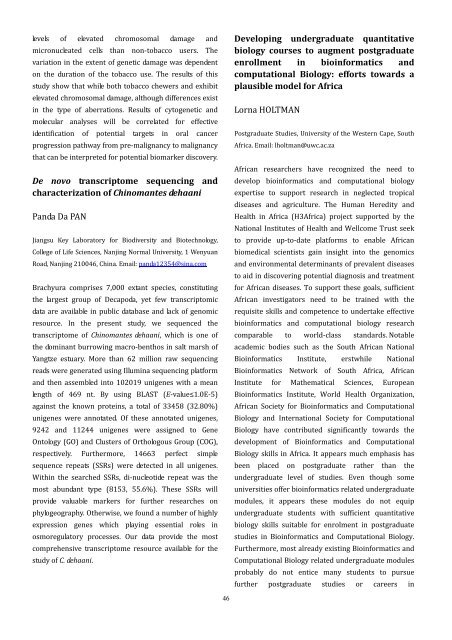Welcome to the 31st IUBS General Assembly and Conference on ...
Welcome to the 31st IUBS General Assembly and Conference on ...
Welcome to the 31st IUBS General Assembly and Conference on ...
You also want an ePaper? Increase the reach of your titles
YUMPU automatically turns print PDFs into web optimized ePapers that Google loves.
levels of elevated chromosomal damage <str<strong>on</strong>g>and</str<strong>on</strong>g><br />
micr<strong>on</strong>ucleated cells than n<strong>on</strong>‐<str<strong>on</strong>g>to</str<strong>on</strong>g>bacco users. The<br />
variati<strong>on</strong> in <str<strong>on</strong>g>the</str<strong>on</strong>g> extent of genetic damage was dependent<br />
<strong>on</strong> <str<strong>on</strong>g>the</str<strong>on</strong>g> durati<strong>on</strong> of <str<strong>on</strong>g>the</str<strong>on</strong>g> <str<strong>on</strong>g>to</str<strong>on</strong>g>bacco use. The results of this<br />
study show that while both <str<strong>on</strong>g>to</str<strong>on</strong>g>bacco chewers <str<strong>on</strong>g>and</str<strong>on</strong>g> exhibit<br />
elevated chromosomal damage, although differences exist<br />
in <str<strong>on</strong>g>the</str<strong>on</strong>g> type of aberrati<strong>on</strong>s. Results of cy<str<strong>on</strong>g>to</str<strong>on</strong>g>genetic <str<strong>on</strong>g>and</str<strong>on</strong>g><br />
molecular analyses will be correlated for effective<br />
identificati<strong>on</strong> of potential targets in oral cancer<br />
progressi<strong>on</strong> pathway from pre‐malignancy <str<strong>on</strong>g>to</str<strong>on</strong>g> malignancy<br />
that can be interpreted for potential biomarker discovery.<br />
De novo transcrip<str<strong>on</strong>g>to</str<strong>on</strong>g>me sequencing <str<strong>on</strong>g>and</str<strong>on</strong>g><br />
characterizati<strong>on</strong> of Chinomantes dehaani<br />
P<str<strong>on</strong>g>and</str<strong>on</strong>g>a Da PAN<br />
Jiangsu Key Labora<str<strong>on</strong>g>to</str<strong>on</strong>g>ry for Biodiversity <str<strong>on</strong>g>and</str<strong>on</strong>g> Biotechnology,<br />
College of Life Sciences, Nanjing Normal University, 1 Wenyuan<br />
Road, Nanjing 210046, China. Email: p<str<strong>on</strong>g>and</str<strong>on</strong>g>a12354@sina.com<br />
Brachyura comprises 7,000 extant species, c<strong>on</strong>stituting<br />
<str<strong>on</strong>g>the</str<strong>on</strong>g> largest group of Decapoda, yet few transcrip<str<strong>on</strong>g>to</str<strong>on</strong>g>mic<br />
data are available in public database <str<strong>on</strong>g>and</str<strong>on</strong>g> lack of genomic<br />
resource. In <str<strong>on</strong>g>the</str<strong>on</strong>g> present study, we sequenced <str<strong>on</strong>g>the</str<strong>on</strong>g><br />
transcrip<str<strong>on</strong>g>to</str<strong>on</strong>g>me of Chinomantes dehaani, which is <strong>on</strong>e of<br />
<str<strong>on</strong>g>the</str<strong>on</strong>g> dominant burrowing macro‐benthos in salt marsh of<br />
Yangtze estuary. More than 62 milli<strong>on</strong> raw sequencing<br />
reads were generated using Illumina sequencing platform<br />
<str<strong>on</strong>g>and</str<strong>on</strong>g> <str<strong>on</strong>g>the</str<strong>on</strong>g>n assembled in<str<strong>on</strong>g>to</str<strong>on</strong>g> 102019 unigenes with a mean<br />
length of 469 nt. By using BLAST (E‐value≤1.0E‐5)<br />
against <str<strong>on</strong>g>the</str<strong>on</strong>g> known proteins, a <str<strong>on</strong>g>to</str<strong>on</strong>g>tal of 33458 (32.80%)<br />
unigenes were annotated. Of <str<strong>on</strong>g>the</str<strong>on</strong>g>se annotated unigenes,<br />
9242 <str<strong>on</strong>g>and</str<strong>on</strong>g> 11244 unigenes were assigned <str<strong>on</strong>g>to</str<strong>on</strong>g> Gene<br />
On<str<strong>on</strong>g>to</str<strong>on</strong>g>logy (GO) <str<strong>on</strong>g>and</str<strong>on</strong>g> Clusters of Orthologous Group (COG),<br />
respectively. Fur<str<strong>on</strong>g>the</str<strong>on</strong>g>rmore, 14663 perfect simple<br />
sequence repeats (SSRs) were detected in all unigenes.<br />
Within <str<strong>on</strong>g>the</str<strong>on</strong>g> searched SSRs, di‐nucleotide repeat was <str<strong>on</strong>g>the</str<strong>on</strong>g><br />
most abundant type (8153, 55.6%). These SSRs will<br />
provide valuable markers for fur<str<strong>on</strong>g>the</str<strong>on</strong>g>r researches <strong>on</strong><br />
phylogeography. O<str<strong>on</strong>g>the</str<strong>on</strong>g>rwise, we found a number of highly<br />
expressi<strong>on</strong> genes which playing essential roles in<br />
osmoregula<str<strong>on</strong>g>to</str<strong>on</strong>g>ry processes. Our data provide <str<strong>on</strong>g>the</str<strong>on</strong>g> most<br />
comprehensive transcrip<str<strong>on</strong>g>to</str<strong>on</strong>g>me resource available for <str<strong>on</strong>g>the</str<strong>on</strong>g><br />
study of C. dehaani.<br />
Developing undergraduate quantitative<br />
biology courses <str<strong>on</strong>g>to</str<strong>on</strong>g> augment postgraduate<br />
enrollment in bioinformatics <str<strong>on</strong>g>and</str<strong>on</strong>g><br />
computati<strong>on</strong>al Biology: efforts <str<strong>on</strong>g>to</str<strong>on</strong>g>wards a<br />
plausible model for Africa<br />
Lorna HOLTMAN<br />
Postgraduate Studies, University of <str<strong>on</strong>g>the</str<strong>on</strong>g> Western Cape, South<br />
Africa. Email: lholtman@uwc.ac.za<br />
African researchers have recognized <str<strong>on</strong>g>the</str<strong>on</strong>g> need <str<strong>on</strong>g>to</str<strong>on</strong>g><br />
develop bioinformatics <str<strong>on</strong>g>and</str<strong>on</strong>g> computati<strong>on</strong>al biology<br />
expertise <str<strong>on</strong>g>to</str<strong>on</strong>g> support research in neglected tropical<br />
diseases <str<strong>on</strong>g>and</str<strong>on</strong>g> agriculture. The Human Heredity <str<strong>on</strong>g>and</str<strong>on</strong>g><br />
Health in Africa (H3Africa) project supported by <str<strong>on</strong>g>the</str<strong>on</strong>g><br />
Nati<strong>on</strong>al Institutes of Health <str<strong>on</strong>g>and</str<strong>on</strong>g> Wellcome Trust seek<br />
<str<strong>on</strong>g>to</str<strong>on</strong>g> provide up‐<str<strong>on</strong>g>to</str<strong>on</strong>g>‐date platforms <str<strong>on</strong>g>to</str<strong>on</strong>g> enable African<br />
biomedical scientists gain insight in<str<strong>on</strong>g>to</str<strong>on</strong>g> <str<strong>on</strong>g>the</str<strong>on</strong>g> genomics<br />
<str<strong>on</strong>g>and</str<strong>on</strong>g> envir<strong>on</strong>mental determinants of prevalent diseases<br />
<str<strong>on</strong>g>to</str<strong>on</strong>g> aid in discovering potential diagnosis <str<strong>on</strong>g>and</str<strong>on</strong>g> treatment<br />
for African diseases. To support <str<strong>on</strong>g>the</str<strong>on</strong>g>se goals, sufficient<br />
African investiga<str<strong>on</strong>g>to</str<strong>on</strong>g>rs need <str<strong>on</strong>g>to</str<strong>on</strong>g> be trained with <str<strong>on</strong>g>the</str<strong>on</strong>g><br />
requisite skills <str<strong>on</strong>g>and</str<strong>on</strong>g> competence <str<strong>on</strong>g>to</str<strong>on</strong>g> undertake effective<br />
bioinformatics <str<strong>on</strong>g>and</str<strong>on</strong>g> computati<strong>on</strong>al biology research<br />
comparable <str<strong>on</strong>g>to</str<strong>on</strong>g> world‐class st<str<strong>on</strong>g>and</str<strong>on</strong>g>ards. Notable<br />
academic bodies such as <str<strong>on</strong>g>the</str<strong>on</strong>g> South African Nati<strong>on</strong>al<br />
Bioinformatics Institute, erstwhile Nati<strong>on</strong>al<br />
Bioinformatics Network of South Africa, African<br />
Institute for Ma<str<strong>on</strong>g>the</str<strong>on</strong>g>matical Sciences, European<br />
Bioinformatics Institute, World Health Organizati<strong>on</strong>,<br />
African Society for Bioinformatics <str<strong>on</strong>g>and</str<strong>on</strong>g> Computati<strong>on</strong>al<br />
Biology <str<strong>on</strong>g>and</str<strong>on</strong>g> Internati<strong>on</strong>al Society for Computati<strong>on</strong>al<br />
Biology have c<strong>on</strong>tributed significantly <str<strong>on</strong>g>to</str<strong>on</strong>g>wards <str<strong>on</strong>g>the</str<strong>on</strong>g><br />
development of Bioinformatics <str<strong>on</strong>g>and</str<strong>on</strong>g> Computati<strong>on</strong>al<br />
Biology skills in Africa. It appears much emphasis has<br />
been placed <strong>on</strong> postgraduate ra<str<strong>on</strong>g>the</str<strong>on</strong>g>r than <str<strong>on</strong>g>the</str<strong>on</strong>g><br />
undergraduate level of studies. Even though some<br />
universities offer bioinformatics related undergraduate<br />
modules, it appears <str<strong>on</strong>g>the</str<strong>on</strong>g>se modules do not equip<br />
undergraduate students with sufficient quantitative<br />
biology skills suitable for enrolment in postgraduate<br />
studies in Bioinformatics <str<strong>on</strong>g>and</str<strong>on</strong>g> Computati<strong>on</strong>al Biology.<br />
Fur<str<strong>on</strong>g>the</str<strong>on</strong>g>rmore, most already existing Bioinformatics <str<strong>on</strong>g>and</str<strong>on</strong>g><br />
Computati<strong>on</strong>al Biology related undergraduate modules<br />
probably do not entice many students <str<strong>on</strong>g>to</str<strong>on</strong>g> pursue<br />
fur<str<strong>on</strong>g>the</str<strong>on</strong>g>r postgraduate studies or careers in<br />
46
















